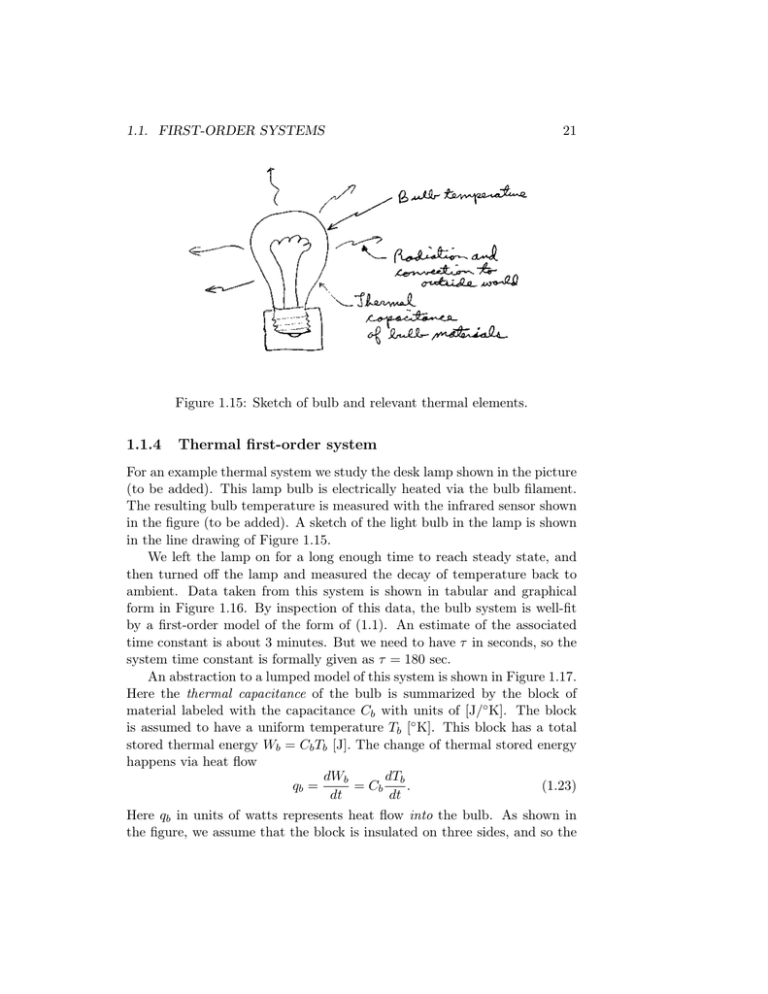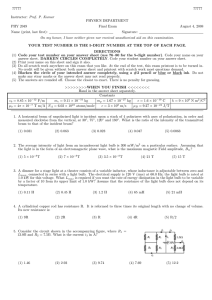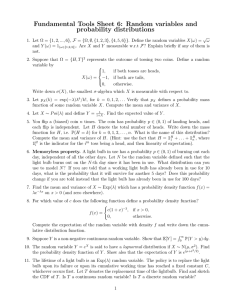1.1.4 Thermal first-order system
advertisement

1.1. FIRST-ORDER SYSTEMS 21 Figure 1.15: Sketch of bulb and relevant thermal elements. 1.1.4 Thermal first-order system For an example thermal system we study the desk lamp shown in the picture (to be added). This lamp bulb is electrically heated via the bulb filament. The resulting bulb temperature is measured with the infrared sensor shown in the figure (to be added). A sketch of the light bulb in the lamp is shown in the line drawing of Figure 1.15. We left the lamp on for a long enough time to reach steady state, and then turned o↵ the lamp and measured the decay of temperature back to ambient. Data taken from this system is shown in tabular and graphical form in Figure 1.16. By inspection of this data, the bulb system is well-fit by a first-order model of the form of (1.1). An estimate of the associated time constant is about 3 minutes. But we need to have ⌧ in seconds, so the system time constant is formally given as ⌧ = 180 sec. An abstraction to a lumped model of this system is shown in Figure 1.17. Here the thermal capacitance of the bulb is summarized by the block of material labeled with the capacitance Cb with units of [J/ K]. The block is assumed to have a uniform temperature Tb [ K]. This block has a total stored thermal energy Wb = Cb Tb [J]. The change of thermal stored energy happens via heat flow dWb dTb qb = = Cb . (1.23) dt dt Here qb in units of watts represents heat flow into the bulb. As shown in the figure, we assume that the block is insulated on three sides, and so the 22 CHAPTER 1. NATURAL RESPONSE Figure 1.16: Data from light bulb cooling experiment. # B 4B 2B 44A 4HERMALRESISTANCE TOOUTSIDEWORLD "ULBTHERMALCAPACITANCE Figure 1.17: Lumped model for bulb cooling experiment. 23 1.1. FIRST-ORDER SYSTEMS heat flow through those sides is zero. The block is connected to the outside ambient temperature via the thermal resistance Rb , such that qb = Ta Tb Rb (1.24) . This resistance represents the flow of heat into the bulb as a linear function of the temperature di↵erence4 between the ambient and the bulb temperatures. Setting equality between the last two equations gives Cb dTb T a Tb = . dt Rb (1.25) Now, it’s convenient to define a variable to represent the temperature difference between the bulb and ambient: T ⌘ Tb Ta . Since the ambient temperature is constant, dT /dt = dTb /dt. Making these substitutions and multiplying (1.25) through by Rb yields Rb Cb dT + T = 0. dt (1.26) If we define ⌧ = Rb Cb , this is in the form of (1.1). The natural response is thus as calculated in section 1.1, with its associated figures. Specifically, if the initial temperature di↵erence of the bulb is defined as T (0) = T0 , then the temperature di↵erence as a function of time varies as T (t) = T0 e t/Rb Cb [K]. (1.27) If you want to convert back to the absolute temperature of the bulb, remember that Tb = T + Ta . 1.1.5 Fluidic first-order system A fluidic system which can be modeled with a first-order di↵erential equation is shown in Figure 1.18. Here a tank filled with liquid drains through a long, thin pipe. The height of the liquid above the pipe inlet is defined as h. If we assume that the liquid has a density of ⇢ [kg/m3 ], then the pressure Pt at 4 In real systems, more exact and likely nonlinear models can apply, but a linear model gives a first understanding of this system response, and is well able to match the measured behavior. For example, pure radiative cooling varies as temperature di↵erence to the fourth power, which is highly nonlinear. There will certainly be radiative heat flow in this system, however, the experimental data fits well to a linear heat flow model which suggests that radiative cooling is not highly significant at the bulb envelope temperatures of 100 C and down to ambient. MIT OpenCourseWare http://ocw.mit.edu 2.14 / 2.140 Analysis and Design of Feedback Control Systems Spring 2014 For information about citing these materials or our Terms of Use, visit: http://ocw.mit.edu/terms.




